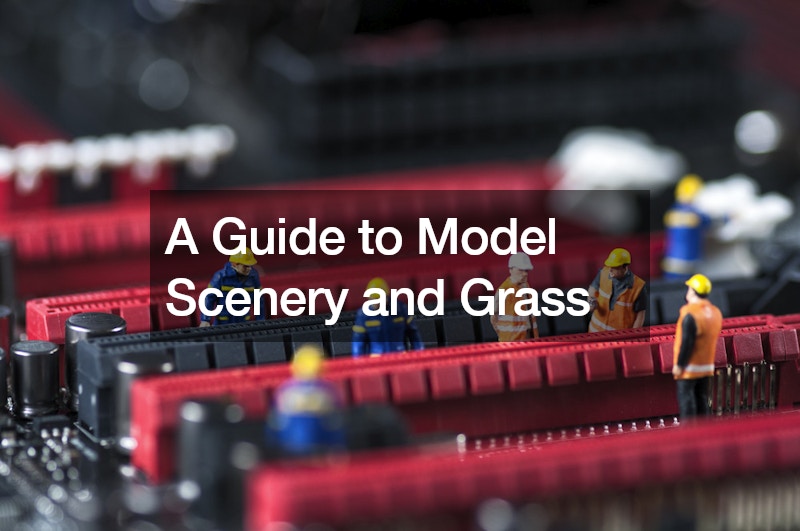Model scenery and grass are essential elements in creating captivating dioramas, intricate model railroad layouts, and immersive wargaming terrains. Whether you’re a novice or one of the model scenery & static grass experts, understanding the nuances of model scenery and grass can significantly enhance the realism and visual appeal of your projects. In this comprehensive guide, we’ll delve into various products, techniques, and practical tips to help you master the art of model scenery and grass.
Getting to Know Static Grass:
Static grass is a versatile material used to replicate the appearance of grass in miniature landscapes. It comes in different sizes and colors, allowing for customization to suit various environments and seasons. To effectively apply static grass, invest in a quality applicator like the Static King. This device ensures precise vertical application, mimicking the natural growth pattern of grass. Alternatively, for those on a budget, homemade static grass applicators using household materials such as sieves and PVC pipes can also yield satisfactory results.
Managing Mess with Model Vac and Alternatives:
Working with static grass and other flocking materials can create a mess. To maintain a tidy workspace and efficiently manage debris, consider using the Model Vac or a similar vacuum device specifically designed for modeling purposes. Additionally, a simple handheld vacuum cleaner with a small attachment can serve as a budget-friendly alternative for cleaning up excess materials.
Adding Depth with Tufts, Plant Hues, and Flowers:
To elevate your model landscapes beyond basic grass, incorporate tufts, plant hues, and flowers for added depth and realism. Tufts, made using Tough Tech adhesive and static grass or field grass, provide texture and variation to your terrain. Plant hues are ideal for simulating seed heads, enhancing shadows, and creating subtle tonal variations. Similarly, flowers can be strategically placed to represent blooming trees, bushes, and flowerbeds, injecting vibrant bursts of color into your scenery.
Enhancing Realism with Briarpatch and Similar Products:
For those seeking to replicate rugged wilderness terrain, consider using briarpatch or similar products. These textured materials are perfect for modeling dense shrubs, thorny thickets, and wild bramble patches commonly found on the outskirts of fields and forests. Utilize static tack, scenic glue, or hobby tacks for effortless application, ensuring seamless integration into your landscape.
Exploring Wargaming Applications:
Model scenery and grass are not only integral to dioramas and model railroads but also play a crucial role in wargaming terrain design. In wargaming, realistic terrain enhances gameplay immersion and strategic depth. Incorporate varying terrain features such as hills, forests, and open fields to create dynamic battlegrounds. Utilize static grass and flocking materials to simulate grasslands, marshes, or arid desert landscapes, providing visual interest and tactical challenges for players.
In wargaming, the terrain is not just a backdrop but a crucial aspect of gameplay strategy and immersion. Games like Warhammer 40,000, Dungeons & Dragons, and Flames of War rely heavily on realistic terrain to enhance the gaming experience. For Warhammer 40,000, players often recreate intricate battlefields featuring rugged terrain, ruined cities, and alien landscapes. By incorporating static grass and flocking materials, players can simulate lush grasslands, barren wastelands, or desolate battlefields ravaged by war.
Dungeons & Dragons enthusiasts utilize model scenery to bring their tabletop adventures to life. From dense forests and treacherous mountain passes to mysterious dungeons and ancient ruins, the possibilities for terrain design are limitless. Static grass and other texturing materials help set the scene, allowing players to immerse themselves in fantastical realms filled with peril and adventure.
Getting Started with a Static Grass Starter Kit:
For beginners eager to embark on their modeling journey, a static grass starter kit is an excellent entry point. These kits typically include a shaker applicator and essential materials needed to learn the fundamentals of static grass application and create a small-scale diorama. Experiment with different techniques and textures to develop your skills and gain confidence in modeling realistic landscapes.
Harnessing Community Resources:
Tap into the wealth of knowledge and inspiration available within the model scenery & static grass enthusiast community. Online forums, social media groups, and modeling communities offer valuable insights, tutorials, and support from fellow hobbyists. Engage with experienced modelers, share your projects, and seek feedback to refine your techniques and expand your repertoire.
Conclusion:
Mastering model scenery and grass is a rewarding journey that requires experimentation, creativity, and dedication. By leveraging quality products, exploring diverse techniques, and drawing inspiration from the vibrant modeling community, you can create captivating landscapes that transport viewers to miniature worlds teeming with realism and imagination. Whether you’re crafting a scenic diorama, constructing a detailed railroad layout, or designing immersive wargaming terrain, the possibilities are endless. Embrace the process, enjoy the journey, and let your creativity flourish as you bring your model landscapes to life.

